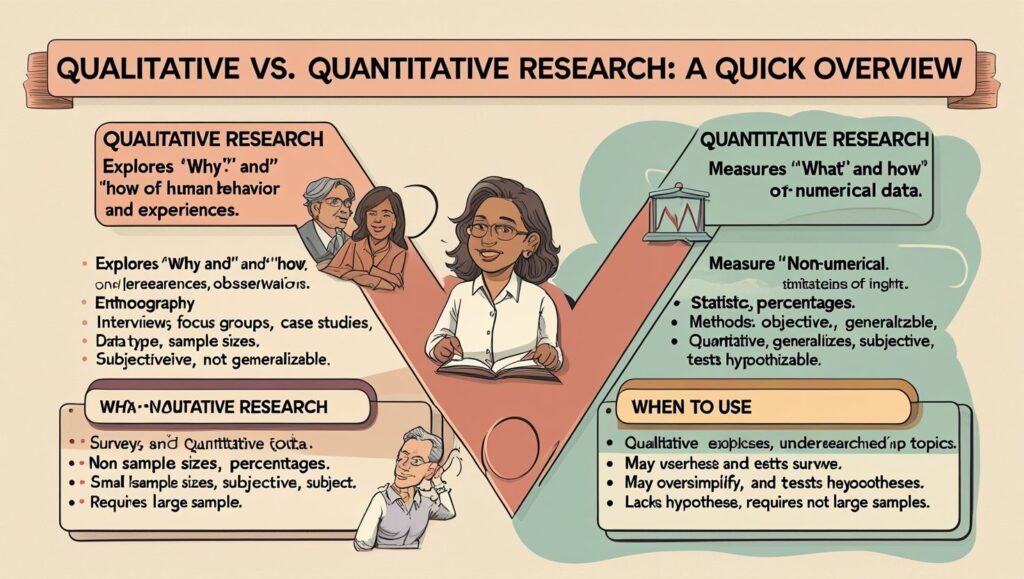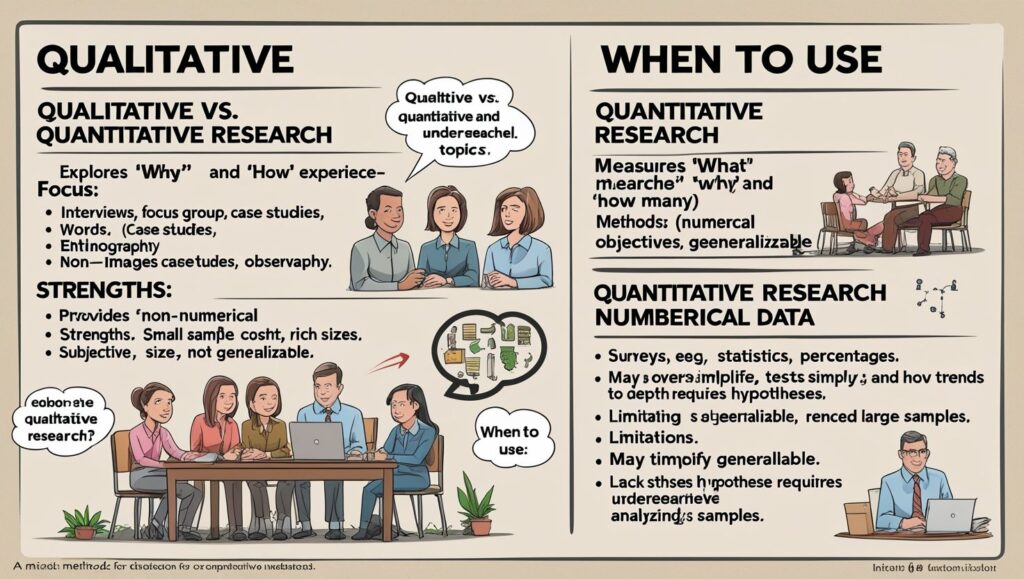Qualitative vs. Quantitative Research, Research is the backbone of knowledge creation, innovation, and problem-solving across various fields, including social sciences, natural sciences, business, and healthcare. Two primary research methodologies dominate the landscape: qualitative and quantitative research. While both approaches aim to gather and analyze data to answer research questions, they differ significantly in their objectives, methods, and applications. This article explores the key differences between qualitative and quantitative research, their strengths and limitations, and how they can be used effectively.
What is Qualitative Research?
Qualitative research is an exploratory approach that seeks to understand human behavior, experiences, and social phenomena in depth. It focuses on the “why” and “how” of decision-making, rather than the “what” or “how many.” This method is often used when the research question is complex, and numerical data alone cannot provide a complete picture.
Key Characteristics of Qualitative Research
- Nature of Data: Qualitative research deals with non-numerical data, such as words, images, or observations. It aims to capture the richness and complexity of human experiences.
- Sample Size: Typically involves smaller sample sizes, as the focus is on depth rather than breadth.
- Methods: Common methods include interviews, focus groups, case studies, ethnography, and content analysis.
- Flexibility: The research design is often flexible and iterative, allowing researchers to adapt their approach as new insights emerge.
- Subjectivity: Researchers play an active role in interpreting data, which introduces a degree of subjectivity.
Strengths of Qualitative Research
- Provides deep insights into complex issues.
- Captures the context and nuances of human behavior.
- Allows for the exploration of new or under-researched topics.
- Encourages open-ended responses, enabling participants to express themselves freely.
Limitations of Qualitative Research
- Findings may not be generalizable to larger populations due to small sample sizes.
- Subjectivity in data interpretation can lead to bias.
- Time-consuming and labor-intensive.
- Difficult to replicate due to the unique nature of each study.

What is Quantitative Research?
Quantitative research is a systematic approach that focuses on quantifying data and analyzing numerical patterns. It aims to test hypotheses, establish relationships, and make predictions using statistical methods. This approach is often used when the research question requires measurable, objective data.
Key Characteristics of Quantitative Research
- Nature of Data: Quantitative research deals with numerical data, which can be analyzed using statistical tools.
- Sample Size: Typically involves larger sample sizes to ensure statistical validity and generalizability.
- Methods: Common methods include surveys, experiments, longitudinal studies, and secondary data analysis.
- Rigidity: The research design is structured and predetermined, with little room for deviation.
- Objectivity: Researchers aim to minimize bias by using standardized procedures and tools.
Strengths of Quantitative Research
- Provides precise, measurable data.
- Allows for generalization to larger populations.
- Enables hypothesis testing and statistical analysis.
- Results are often replicable and comparable across studies.
Limitations of Quantitative Research
- May oversimplify complex phenomena by reducing them to numbers.
- Lacks depth and context, as it focuses on quantifiable aspects.
- Requires a well-defined research question and hypothesis.
- Can be expensive and time-consuming, especially for large-scale studies.
Key Differences Between Qualitative and Quantitative Research
| Aspect | Qualitative Research | Quantitative Research |
|---|---|---|
| Objective | Explore, understand, and interpret | Measure, test, and predict |
| Data Type | Non-numerical (words, images, etc.) | Numerical (numbers, statistics) |
| Sample Size | Small | Large |
| Methods | Interviews, focus groups, case studies | Surveys, experiments, statistical analysis |
| Flexibility | Flexible and adaptive | Structured and rigid |
| Analysis | Thematic, narrative, or content analysis | Statistical analysis |
| Generalizability | Limited | High |
| Researcher’s Role | Subjective and interpretive | Objective and detached |
When to Use Qualitative vs. Quantitative Research
The choice between qualitative and quantitative research depends on the research question, objectives, and context.
Use Qualitative Research When:
- The research question is exploratory or open-ended.
- You need to understand the underlying reasons, motivations, or experiences.
- The topic is complex and requires in-depth analysis.
- You want to develop new theories or frameworks.
Use Quantitative Research When:
- The research question is specific and requires measurable data.
- You need to test hypotheses or establish causal relationships.
- Generalizability to a larger population is important.
- You want to analyze trends, patterns, or correlations.

Combining Qualitative and Quantitative Research: Mixed Methods
In many cases, researchers use a mixed-methods approach, combining qualitative and quantitative techniques to leverage the strengths of both. For example:
- A researcher might conduct interviews (qualitative) to explore a phenomenon and then use surveys (quantitative) to test the findings on a larger scale.
- Alternatively, a quantitative study might be followed by qualitative interviews to provide context and depth to the numerical data.
Mixed methods can provide a more comprehensive understanding of the research problem, but they also require careful planning and integration of data.
Examples of Qualitative and Quantitative Research
Qualitative Research Example
A study exploring the experiences of cancer patients undergoing chemotherapy might involve in-depth interviews to understand their emotional, psychological, and social challenges. The researcher would analyze the responses to identify common themes, such as fear, hope, or resilience.
Quantitative Research Example
A study examining the relationship between exercise and mental health might involve a survey of 1,000 participants. The researcher would use statistical analysis to determine whether there is a significant correlation between physical activity levels and self-reported mental well-being.
Conclusion
Qualitative and quantitative research are two distinct but complementary approaches to understanding the world. Qualitative research excels at exploring complex, nuanced phenomena, while quantitative research provides measurable, generalizable data. The choice between the two depends on the research question, objectives, and context. In many cases, a mixed-methods approach can offer the best of both worlds, providing both depth and breadth of understanding. By carefully selecting and applying these methodologies, researchers can generate valuable insights that drive knowledge and innovation across disciplines.

6 thoughts on “Qualitative vs. Quantitative Research”
Comments are closed.